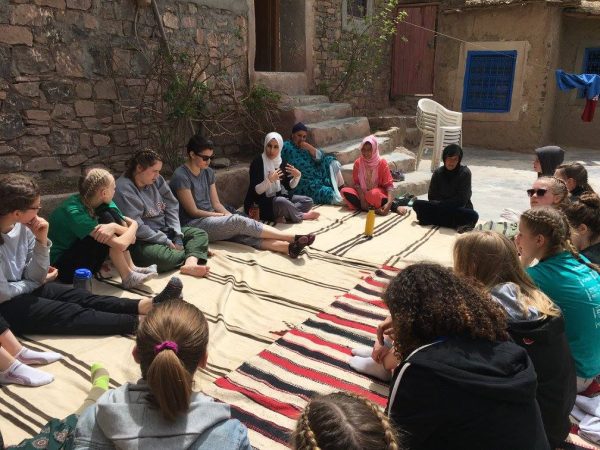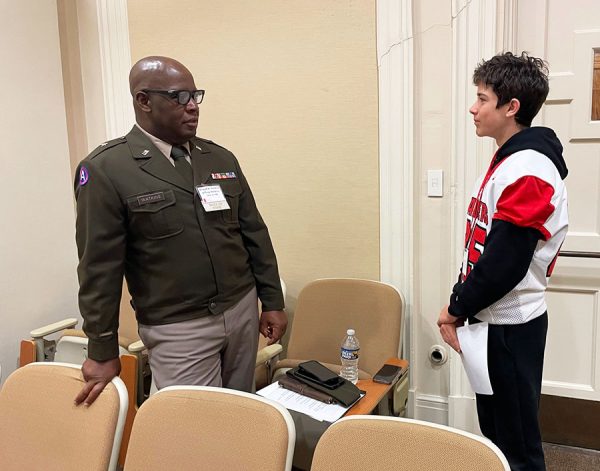New Test, With a Side of Stress
Sophomore year is a year of firsts.
The first Advanced Placement classes and exams. The first time behind the wheel. The first year of not being a freshman. And this year, the first time sitting in a cardboard cubicle for five hours clicking answers to a test your teacher didn’t even write.
Tenth graders took the inaugural ASPIRE test Sept. 30 – Oct. 2 in the multi-purpose room, Room 253 B and the library. Administered by computer and four to five hours long, the test occurred in unfamiliar environments.
The ASPIRE test is not state mandated; the district chose to administer it in place of the PLAN test, which was discontinued last spring. The ASPIRE test is created by the ACT Aspire company to help prepare students for the ACT. The PLAN test was administered for program planning purposes and included questions that helped suggest career options for students.
The ASPIRE test is aligned with Common Core standards: a set of clear college and career-ready standards for kindergarten through twelfth grade used in 43 states. ASPIRE is available for third through tenth grade. The categories of the test include English, math, reading and science and three types of responses: constructed (written), selected (multiple choice) and technology-enhanced (interactive).
Some sophomores didn’t see the purpose of the ASPIRE test. “I had mixed feelings. It was bad because the environment made it very hard to concentrate,” sophomore Margaret Cook said. “It’s making the school year harder.”
Some students saw possible benefits of the test. “You learn what the general format and questions [on the ACT] are like, and you learn what you have to work on,” sophomore Isabel Wang said. “For example, science for me.”
In the testing room, students were divided by cardboard carrels that resembled tri-fold boards. They were not permitted to leave the room for lunch, but were provided lunches.
Parents of sophomores gave their opinions on the test itself and the effects it had on their children. Anja DeGeorgia, parent of sophomore Nadia DeGeorgia, said, “I think that all tests are stressful.”
Angela Christopher, parent of sophomore Mikayla Christopher said, “The ASPIRE test is too much.”
Guidance counselor Catherine Szendrey voices similar concerns. “I worry about the stress on the sophomores,” she said.
Nurse Paula Damm shared that students of all ages come to her office for help when feeling stress. She said that although she does not ask the cause of stress, she has noticed that students’ concerns vary by grade. While freshmen tend to come in because they are new, tenth-graders visit her office with stress concerns because of testing and having a lot to do.
Sophomores also weighed in on taking standardized tests on computers rather than with pencil and paper booklets. “I hated taking it on the computer. I had a headache from staring at the screen for five hours,” sophomore Nathan Hill said.
Although Shaker chose to administer the ASPIRE test, Ohio requires annual end-of-course exams in every core subject for all students. For English and math, Ohio will use tests created by PARCC, the Partnership for Assessment of Readiness for College and Careers, which is a coalition of 18 states and the District of Columbia that devises exams to align with the Common Core State Standards. For science and social studies, Ohio will use tests created by another company.
These tests will occur in two stages: a written test in March and a computer-administered test in May.
ASPIRE testing allowed students to become acquainted with computer-administered testing. District Director of Research and Accountability Dale Whittington said the technical aspects included equipment, bandwidth, administration training, how to deal with technical issues when they arise, setting up sessions and determining what students need to know about the online assessment. Sophomores were showed how to use the online calculator, highlight text and review their test before submitting it.
Whittington said, “While things were not perfect, they went smoothly for a first time, and we know much more about what we need to do to make the PARCC work.”
The ACT Aspire company typically charges $20 per student for the computer ASPIRE test (the paper test costs $5 per student). But, Whittington said, because Shaker conducted a 20-student field trial of the test last spring, the price was cut in half. Giving the ASPIRE test to the sophomore class cost $4,850. According to Whittington, the school district is paying this expense. There are 1.8 million annual administrations of the test nationwide, according to ACT Aspire.
Sophomores are the first at the high school to experience the new breed of standardized testing, which already has or will soon affect the lives of all students. The 5 year olds in Shaker kindergarten classrooms have already used computers to complete tests such as the Kindergarten Readiness Assessment and Measures of Academic Progress. These tests were used to evaluate the kindergarteners on their skills in math, language arts, motor skills and interaction with their peers.
Wang said, “We are treating students like a number or score on a paper instead of the individuals that we are, with all of our different qualities.”





